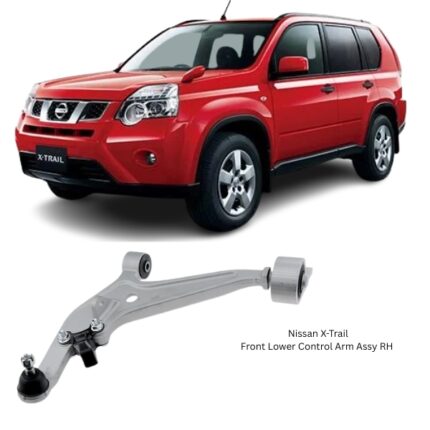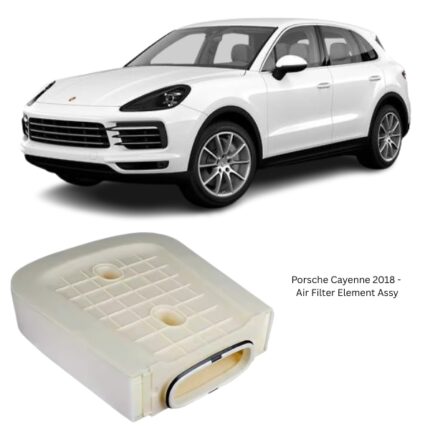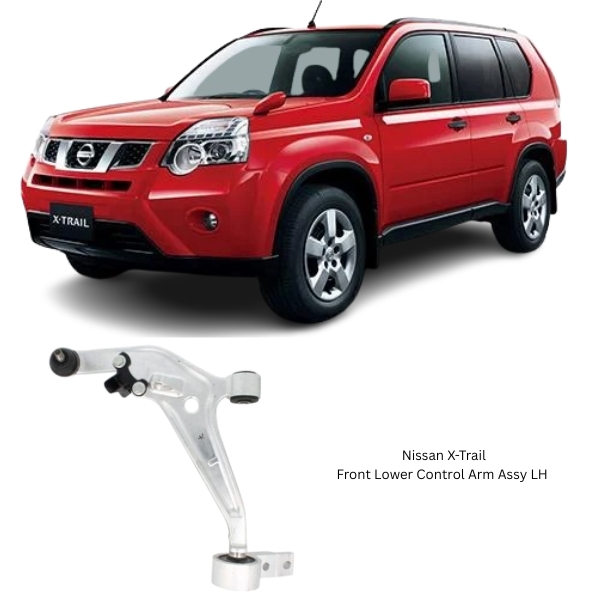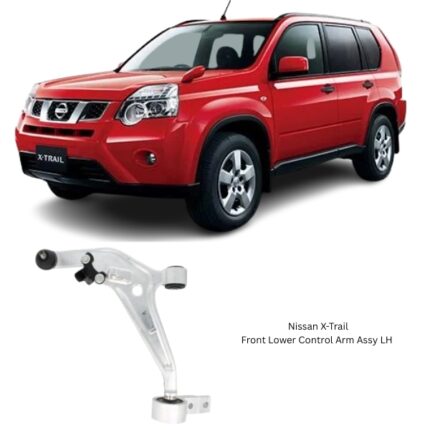Get Nissan X-Trail T30 Front Lower Control Arm Assy LH 54501-8H310 in Kenya
The Front Lower Control Arm Assembly RH (Right-Hand) is a vital component of the front suspension system in modern vehicles. Located on the front-right (passenger) side, this part serves as a structural link between the vehicle’s frame and the steering knuckle. It ensures the wheel remains correctly aligned during suspension travel, maintains stability during cornering and braking, and contributes significantly to both safety and ride quality. Whether for a daily driver, off-road vehicle, or performance car, a well-functioning lower control arm is indispensable.
1. Purpose and Function of the Front Lower Control Arm Assembly RH
The primary function of the Front Lower Control Arm RH is to allow the wheel to move vertically (up and down) with road irregularities while holding the wheel laterally in the proper alignment relative to the vehicle’s body. This movement is essential for absorbing road shocks, improving traction, and enhancing control.
In addition to providing flexibility, the control arm plays a key role in:
-
Maintaining the camber angle of the wheel.
-
Supporting steering stability.
-
Reducing vibration and noise transmission.
-
Sustaining proper suspension geometry.
2. Key Components of a Control Arm Assembly
The complete control arm assembly generally includes the following parts:
a) Arm Structure
-
Constructed from high-strength materials such as forged steel, aluminum, or cast iron.
-
Shaped in “L”, “A”, or wishbone form to provide structural rigidity while accommodating motion and loads.
b) Bushings
-
Usually made from rubber or polyurethane.
-
Installed at the pivot point where the arm connects to the chassis.
-
Absorb vibrations and reduce friction between metal components.
c) Ball Joint
-
Connects the outer end of the control arm to the steering knuckle.
-
Allows the wheel to rotate left or right (for steering) while also moving vertically with suspension travel.
d) Mounting Brackets and Bolts
-
Used to secure the control arm to the vehicle’s subframe or crossmember.
3. How It Works in the Suspension System
The Front Lower Control Arm RH works as part of a network of suspension components that support the vehicle’s weight, respond to terrain, and maintain wheel alignment. It allows the wheel to move independently of the body while keeping it at the correct orientation.
During driving:
-
The ball joint allows for steering motion and suspension travel simultaneously.
-
The bushings pivot to let the arm move up and down.
-
Together, they allow the suspension to compress over bumps, extend over dips, and absorb road shocks.
4. Importance of a Properly Functioning RH Control Arm
-
Accurate Steering Response: Ensures the wheel’s position remains consistent, helping the vehicle respond predictably to driver input.
-
Improved Tire Wear: Maintains proper alignment, preventing premature or uneven tread wear.
-
Ride Comfort: Absorbs noise and harshness from the road surface.
-
Safety: Maintains suspension integrity and keeps tires in firm contact with the road.
-
Fuel Efficiency: Proper alignment reduces rolling resistance and drag.
5. Symptoms of a Failing Front Lower Control Arm RH
Over time, bushings degrade and ball joints become loose. When this happens, drivers may experience:
-
Clunking or Popping Noise – Especially when going over bumps or during sudden braking/acceleration.
-
Vibration Through the Steering Wheel – Caused by looseness or misalignment in the suspension.
-
Poor Handling or Steering Drift – Vehicle may pull to one side or feel unstable during turns.
-
Uneven Tire Wear – Due to camber or toe misalignment from a bent or worn control arm.
-
Braking Instability – Nose diving or jerking when stopping may indicate worn bushings or joints.
6. Common Causes of Damage or Wear
-
Age and Usage: Bushings and ball joints naturally degrade with time and mileage.
-
Harsh Terrain: Regular driving on rough or off-road surfaces accelerates wear.
-
Curb/Pothole Impact: A sudden jolt can bend the arm or damage the bushings.
-
Corrosion: Especially in older steel arms exposed to road salt and moisture.
-
Overloading: Exceeding the vehicle’s load limit puts additional stress on suspension components.
7. Inspection and Diagnosis
Mechanics can assess the health of a control arm during suspension checks or alignments:
-
Visual Inspection: Look for torn bushings, rust, cracks, or impact damage.
-
Pry Bar Test: Used to detect play in bushings or looseness in ball joints.
-
Tire Wear Patterns: Abnormal wear may indicate control arm issues.
-
Suspension Movement Test: Observe movement under braking or steering for signs of excess travel or instability.
8. Replacing the Front Lower Control Arm RH
If diagnosed as faulty, the control arm should be replaced promptly. Replacement involves:
Required Tools:
-
Jack and jack stands
-
Socket and wrench set
-
Torque wrench
-
Ball joint separator
-
Pry bar
-
Safety gloves
Steps:
-
Secure and Raise Vehicle: Use jack stands for safety after lifting the front-right side.
-
Remove the Wheel: To expose the control arm.
-
Detach the Ball Joint: Separate it from the steering knuckle using a ball joint tool.
-
Unbolt the Arm: Remove mounting bolts securing it to the subframe.
-
Install New Control Arm: Align and fasten bolts to torque spec.
-
Reconnect Ball Joint: Ensure it’s properly seated and tightened.
-
Reinstall Wheel and Lower Vehicle
-
Perform a Wheel Alignment: Necessary to restore factory handling and tire performance.
9. Maintenance Tips for Long Control Arm Life
-
Routine Inspections: Check the suspension system at every oil change or tire rotation.
-
Avoid Harsh Impacts: Drive slowly over speed bumps and avoid curbs.
-
Clean Undercarriage: Prevent corrosion by washing off dirt, salt, and grime regularly.
-
Lubricate Joints (if applicable): Some control arms have serviceable joints.
-
Address Early Symptoms: Do not ignore noises, vibrations, or uneven tire wear.
10. Differences Between RH and LH Control Arms
The RH (Right-Hand) and LH (Left-Hand) control arms are not interchangeable. They are designed to mirror each other with side-specific geometry:
-
Ball joint orientation is different.
-
Bushing alignment varies to match each side’s mounting points.
-
Structural shape is side-specific to clear adjacent suspension and engine components.
Always ensure the correct part is used for the intended side to avoid alignment and safety issues.
Follow us on Facebook for more parts.





Reviews
Clear filtersThere are no reviews yet.